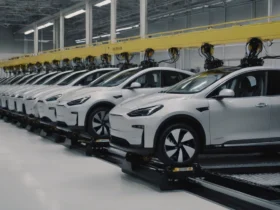Discover the hidden intricacies of Dropbox’s AI dance with OpenAI and how it’s spinning the data privacy narrative in new directions.

Imagine a world where your documents and files take on a life of their own, twirling in a dance choreographed by artificial intelligence. This isn’t a scene from a sci-fi movie but a reality unfolding as we speak. Dropbox, a name synonymous with cloud storage, has recently partnered with OpenAI, inviting discussions and concerns about data privacy. As we navigate this new digital landscape, let’s unravel the Dropbox-OpenAI partnership, its implications, and how this tango affects you and your data.
The AI Waltz: Dropbox’s Move with OpenAI
Dropbox, known for its cloud storage prowess, has recently taken a leap into the AI arena by partnering with OpenAI. This collaboration is not just a casual dance but a strategic move. Without its own AI chatbot to provide services like summarizing documents or answering file-related queries, Dropbox has turned to OpenAI to fill this gap. So, what does this mean for the average Dropbox user? Your files, when you use these AI features, take a brief sojourn on OpenAI’s servers, staying there for up to 30 days. Intriguing, isn’t it?
While this might sound like a benign exchange, it raises eyebrows in the world of data privacy. Dropbox CEO Drew Houston has stated that this data-sharing waltz occurs only when users actively engage with the AI features. But the question remains – are users fully aware of this partnership’s intricate steps?
Behind the Curtains: What Happens to Your Data?
Let’s pull back the curtains on this dance. When you toggle on the AI features in Dropbox, your documents and files get a pass to OpenAI’s servers. This might seem like a backstage pass to an exclusive show, but it’s more than that. Dropbox ensures that only the content relevant to your explicit requests or commands is sent to OpenAI. However, there’s a twist in this plot – if you share files with another person who is using Dropbox AI, your files might still end up on OpenAI’s stage.
This delicate dance raises a critical question about data autonomy. In today’s digital age, where every bit of information is precious, how comfortable are we with our data being part of this AI choreography? Dropbox assures that customer data is not used to train or fine-tune OpenAI’s language models, but the assurance doesn’t entirely dissolve the cloud of concern.
The Privacy Polka: A Dance of Concern
As this AI partnership waltzes forward, it’s not just Dropbox and OpenAI that are in the spotlight. The broader narrative of consumer-facing AI models, like OpenAI’s ChatGPT, Google’s Bard, and Anthropic’s Claude, is drawing attention. Each step in this dance is a step towards a future where AI is deeply intertwined with our digital existence. However, this future is not without its share of privacy pirouettes.
Dropbox’s dance with AI is a paid feature, available through many of its plans, or through its Early Access program. This exclusivity raises another question – what about those who opt out? The answer lies in the settings, where users can turn off the use of third-party AI. But, as in any dance, it takes two to tango. If your dance partner (read: a person you share files with) is still swaying with AI, your data might still make its way to the AI dance floor.
Turning Off the Music: Your Role in the Dance
If you prefer to keep your data away from the AI ballroom, Dropbox provides a way to bow out of this dance. By simply logging into Dropbox, clicking your account icon, and navigating to the Third-Party AI tab in settings, you can toggle the switch to “off.” This action ensures your files stay within the Dropbox realm, away from the AI spotlight.

As we explore this digital dance, we cannot help but wonder about solutions that offer a more secure, self-reliant approach to document management. Enter PaperOffice, an AI-driven problem solver in the world of document management systems. With its advanced AI capabilities, PaperOffice presents a seamless solution that could elegantly address the challenges highlighted by the Dropbox-OpenAI scenario, ensuring that your data doesn’t waltz away without your consent.
Now, let’s shift our focus to the broader implications of this AI partnership and what it means for the future of digital data management.
As we continue our exploration into the entwined world of Dropbox and OpenAI, it becomes increasingly clear that this partnership is more than just a technological pas de deux. It’s a glimpse into a future where AI-driven processes redefine our interaction with digital data. But with this evolution comes a need for heightened awareness and control over our digital footprints.
The Broader Dance Floor: AI’s Role in Data Management
The Dropbox-OpenAI partnership is not an isolated choreography. It’s part of a grander ballroom where AI is increasingly taking the lead. From Google’s Bard to Anthropic’s Claude, AI models are becoming central to how we interact with data. This shift is not just about efficiency; it’s about reshaping the digital landscape. But as AI steps into the spotlight, questions about privacy, autonomy, and consent become more pressing.
The use of AI in data management is a double-edged sword. On one side, it offers unparalleled efficiency, turning mundane tasks into automated processes. On the other, it brings forth concerns about transparency and control. Where does our data go? Who has access to it? And how is it being used? These are questions that need answers as we waltz into this AI-infused future.
The Privacy Tango: Striking a Balance
Striking a balance in this dance is crucial. While AI offers tremendous benefits, respecting user privacy and ensuring data security is paramount. This balance is not just a technical challenge but an ethical one. As AI becomes more sophisticated, so should our approaches to data privacy and security.
Companies like Dropbox, by partnering with AI giants like OpenAI, have opened a dialogue about the future of data management. But this dialogue should not be a monologue. Users, the rightful owners of their data, must have a say in this narrative. It’s about having clear, user-friendly ways to control how and when their data interacts with AI. Transparency is the key to maintaining trust in this ever-evolving dance.

AI-driven DMS: The Future of Data Management
As we ponder the implications of the Dropbox-OpenAI partnership, it’s essential to recognize the broader trend it signifies. AI-driven Document Management Systems (DMS) like PaperOffice are pioneering a future where efficiency and privacy coexist harmoniously. These systems are not just tools for storing and managing data; they are gatekeepers of privacy and efficiency.
An AI-driven DMS offers a nuanced approach to data management. It’s about understanding the delicate balance between automation and human touch. With features like automated filing, intelligent search, and predictive analytics, these systems can transform the way we handle data. But more importantly, they offer control – a chance to dictate the terms of our dance with AI.
Embracing the AI Revolution with Caution
The Dropbox-OpenAI partnership is a microcosm of a larger revolution – a world where AI is an integral part of our digital lives. As we embrace this revolution, caution should be our dance partner. Understanding the nuances of AI partnerships, questioning the status quo, and demanding transparency and control over our data are steps we must take as we waltz into this new era.
In conclusion, as we navigate the complexities of data privacy and AI, let’s not shy away from asking the hard questions. Let’s be active participants in this dance, ensuring that our data remains ours, even as it moves to the rhythm of AI. And as we ponder the future of data management, let’s keep an eye on solutions like PaperOffice, which offer a glimpse into a world where privacy and efficiency are not at odds but in a graceful embrace.
The world of AI and data management is an ever-evolving dance floor. As we step onto it, let’s do so with awareness, control, and a sense of empowerment. This is not just a dance with technology; it’s a dance with our future.







Leave a Review